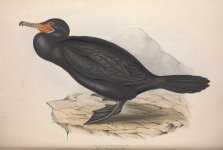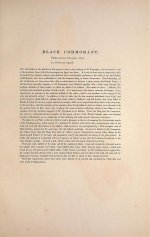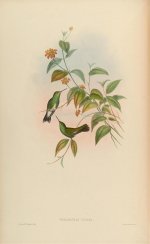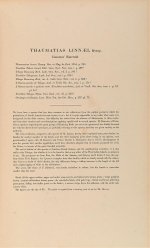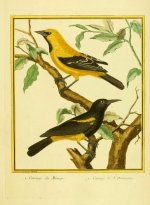Björn Bergenholtz
(former alias "Calalp")

I have three questions regarding some "Linnaean" Synonyms alt. Nomina nuda/dubia …
1: Is the invalid "G. Linnæi" [Graculus Linnæi] GRAY 1845 really synonymous (as claimed by the HBW Alive Key) to "Gulosus aristotelis" [i. e. the Shag (Leucocarbo) Phalacrocorax aristotelis LINNAEUS 1761 a k a "Pelecanus graculus" LINNAEUS 1766] …?!?
When coining this "Linnæi" Mr. Gray only refers to Gould's The Birds of Europe 1837, vol 5, Plate 408. Also see its following text (attached).
But … maybe I stick my head out here: isn´t this Gould's "Phalacrocorax Graculus" simply an adult non-breeding Double-crested Cormorant Phalacrocorax auritus ... !? Even if illustrated vaguely regarding the upper part of the lore and unfortunately not showing its throat in full!? Or an adult, non-breeding, winter specimen (lacking the white patch) of P. carbo sinensis? Though the lesser number of tail feathers (12 instead of 14) points in favour for auritus vs any carbo.
The depicted bird gives, in any case, a much more robust impression than that of a Shag!? Wouldn´t the Artist have made any Shag a bit more slender, more thin-billed and with a steeper fore-head? Do not pay much attention to the red colour of the eye! Or the bright orange bare skin (pointing towards auritus). Soft parts was often, at that time (as well as today), gone by the time any Artist got hold of the specimens. Also worth considering, while reading Gould's (i. e. Temminck's) notes of its distribution, is that the clear distinction between carbo and auritus was far from as well documented as today.
Moreover; the distribution of the Shag is (and surely was) limited to the West Palearctic.
However; does this mean that this "Linnæi" thereby, maybe, is a junior synonym (and if so, of what?) alt. a Numen nudum or Nomen dubium? And if the latter; which one?
Or have I misunderstood the whole thing?
2: And what about: the invalid "Thaumantias "linnæi" BONAPARTE 1854 (without any dedication) and "Thaumatias Linnæi" GOULD 1861: "The term viridissima, assigned to this species by M. Lesson, having been employed many years before by Gmelin for another member of the family, and the other synonyms given above being, in my opinion, very questionable, I agree with M. Bourcier and Prince Charles L. Bonaparte, that it will be advantageous to give the present bird another appellation, and I have therefore adopted that of Linnæi, proposed for it by the Prince, in honour of the great Swedish naturalist." a k a "Linnæus' Emerald". (attached +Plate)
According to the HBW Alive Key it is: "syn. Amazilia fimbriata" (GMELIN 1788) … meaning not (!?) today's subspecies Polytmus guainumbi thaumantias LINNAEUS 1766] ... ?
Of which one is it a synonym?
And the last one, with less doubt, but I´d like some confirmation that I got it right:
3: … the also invalid "Xanthornus linnaei" BONAPARTE (1850?*) [= syn. Icterus nigrogularis HAHN 1819; as "Xanthornus nigrogularis" … ?]
*Here Bonaparte only lists it as his own synonym of "Oriolus xanthornotus", with only one single reference; to the text-less Plate-work Planches enluminées (d'histoire naturelle) Plate 5 (attached), fig. 1, where the bird in question simply is called "Carouge du Méxique" – which surely excludes the synonymity of (as suggested by some) the Asian species; Black-hooded Oriole Oriolus xanthornus LINNAEUS 1758 (as "Coracias Xanthornus") … as well as the fact, the latter being red-billed and all-black-headed.
Anyone disagree?
xxx
1: Is the invalid "G. Linnæi" [Graculus Linnæi] GRAY 1845 really synonymous (as claimed by the HBW Alive Key) to "Gulosus aristotelis" [i. e. the Shag (Leucocarbo) Phalacrocorax aristotelis LINNAEUS 1761 a k a "Pelecanus graculus" LINNAEUS 1766] …?!?
When coining this "Linnæi" Mr. Gray only refers to Gould's The Birds of Europe 1837, vol 5, Plate 408. Also see its following text (attached).
But … maybe I stick my head out here: isn´t this Gould's "Phalacrocorax Graculus" simply an adult non-breeding Double-crested Cormorant Phalacrocorax auritus ... !? Even if illustrated vaguely regarding the upper part of the lore and unfortunately not showing its throat in full!? Or an adult, non-breeding, winter specimen (lacking the white patch) of P. carbo sinensis? Though the lesser number of tail feathers (12 instead of 14) points in favour for auritus vs any carbo.
The depicted bird gives, in any case, a much more robust impression than that of a Shag!? Wouldn´t the Artist have made any Shag a bit more slender, more thin-billed and with a steeper fore-head? Do not pay much attention to the red colour of the eye! Or the bright orange bare skin (pointing towards auritus). Soft parts was often, at that time (as well as today), gone by the time any Artist got hold of the specimens. Also worth considering, while reading Gould's (i. e. Temminck's) notes of its distribution, is that the clear distinction between carbo and auritus was far from as well documented as today.
Moreover; the distribution of the Shag is (and surely was) limited to the West Palearctic.
However; does this mean that this "Linnæi" thereby, maybe, is a junior synonym (and if so, of what?) alt. a Numen nudum or Nomen dubium? And if the latter; which one?
Or have I misunderstood the whole thing?
2: And what about: the invalid "Thaumantias "linnæi" BONAPARTE 1854 (without any dedication) and "Thaumatias Linnæi" GOULD 1861: "The term viridissima, assigned to this species by M. Lesson, having been employed many years before by Gmelin for another member of the family, and the other synonyms given above being, in my opinion, very questionable, I agree with M. Bourcier and Prince Charles L. Bonaparte, that it will be advantageous to give the present bird another appellation, and I have therefore adopted that of Linnæi, proposed for it by the Prince, in honour of the great Swedish naturalist." a k a "Linnæus' Emerald". (attached +Plate)
According to the HBW Alive Key it is: "syn. Amazilia fimbriata" (GMELIN 1788) … meaning not (!?) today's subspecies Polytmus guainumbi thaumantias LINNAEUS 1766] ... ?
Of which one is it a synonym?
And the last one, with less doubt, but I´d like some confirmation that I got it right:
3: … the also invalid "Xanthornus linnaei" BONAPARTE (1850?*) [= syn. Icterus nigrogularis HAHN 1819; as "Xanthornus nigrogularis" … ?]
*Here Bonaparte only lists it as his own synonym of "Oriolus xanthornotus", with only one single reference; to the text-less Plate-work Planches enluminées (d'histoire naturelle) Plate 5 (attached), fig. 1, where the bird in question simply is called "Carouge du Méxique" – which surely excludes the synonymity of (as suggested by some) the Asian species; Black-hooded Oriole Oriolus xanthornus LINNAEUS 1758 (as "Coracias Xanthornus") … as well as the fact, the latter being red-billed and all-black-headed.
Anyone disagree?
xxx
Attachments
Last edited:




